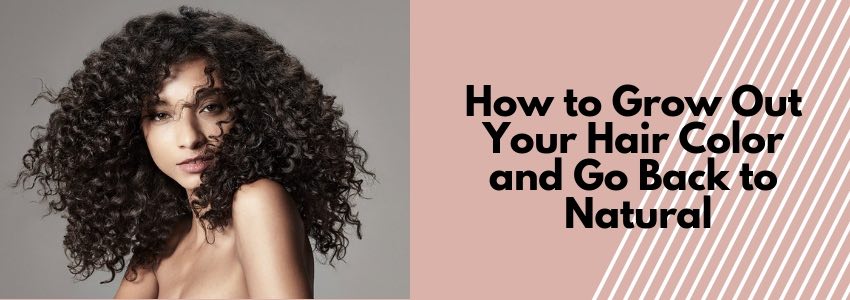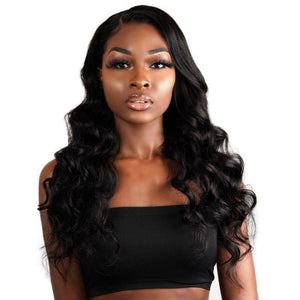Yearning for those naturally lustrous locks after a riot of colors? It's not as tricky as you might think! Let’s dive into the art of gracefully transitioning from vivid hues back to your genuine shade.
Most of us, if not all of us, have gone through a colorful hair phase. We've all had our fair share of hair colors, from bright red to deep purple—some colors we loved, but others we regretted
and outgrew entirely. I remember when I started growing my hair out after rocking a platinum-blonde pixie for years. It was challenging figuring out hairstyles because my roots were dark, and my ends were still platinum blonde!
If you're beginning your healthy hair journey, you've probably come to understand that consistently coloring your hair can be damaging. Frequent color and chemicals, in general, can prevent growth and ruin your curl pattern. If you've colored your hair and are searching for a healthy way to grow out the color, you've come to the right place.
Growing out your hair color is a lengthy process that requires patience and dedication. Different awkward phases will have you itching to grab that box of color and do your hair. However, if you want to get back to your natural hair color, you'll have to resist the temptation and understand that the destination is much more satisfying than the journey! Trust me; your hair will thank you once you've grown out all of that color and begin your healthy hair journey. Growing your hair out hair can be challenging, but it's worth it!
Follow these tips and get that clean slate you want. From highlights, to fully lightened hair to darker locks, the first step to growing out your hair color is to allow some time for your roots to grow. Before you begin this process, please be aware that patience is key!

Knowing When To Go Back To Natural
Most of us love to switch up our looks by changing our hair color or adding a few highlights. No matter the method, our hair strands can become damaged if we're not careful. Chemicals in hair color and lightener can dry out hair, creating brittleness and breakage that will be difficult and sometimes impossible to fix.
Luckily, more and more stylists recommend putting the box of color down and rocking your natural hue. Finding a stylist that's willing to help you grow out your hair color will be easy!

Start Planning
Before you begin the process of reverting to your natural hair color, you'll need to plan. Work alongside a colorist can help you find the best means for what you're trying to achieve. Make sure you let your stylist know what products you have been using. Also, if you have pictures of your natural color show them to your stylist. Colored natural hair requires more maintenance than normal. It may take a while to revert back.
Prepare yourself for the weeks of growth that will have your hair looking a little wild, especially if your natural hair color and your current hair color completely contrast. By accurately planning, you will be able to manage this practice that will surely test your patience.

Say So Long To Highlights
Highlights are lovely and a great way to add radiance to your overall look. However, sometimes highlights can be tiring to maintain. Highlights can also be disastrous if not done right. There are different types of highlights that require various kinds of growth processes to create natural-looking locks seamlessly. If you've gone the balayage route, your transition will be much smoother. Just visit your stylist every six weeks for routine upkeep, and you'll be back to your regular hair color in no time.
If your highlights start from your scalp, it'll take longer. No matter what colorist you choose, they should use lowlights to contrast with your highlights and space them out. By doing this, you'll let your natural hair color and your highlights blend to create a multi-tonal look. This will help reduce the effects of the highlights that you want to grow out.
If you'd like to soften the contrast between your natural color, and your highlights, your colorist should use a toner to create a middle color that'll help ease your standard color back into full effect.

Bye, Bye Pastels
Within the past few years, the unicorn hair trend has skyrocketed. This trend is a vibrant and exciting way to spice up your look, but not necessarily a style to keep for more than a few months. So, if you're over being a unicorn, you'll need to take steps to get back to normalcy, or at least be a unicorn with not as bright hair.
Thankfully, these dazzling colors are not terrible to ditch. In most cases, unicorn dyes are temporary and easy to wash out. You won't have to worry about waiting until your hair grows out. Typically, your hair color will fade, and by this point, you should be visiting your colorist. You'll need to apply an all-over, non-toxic dye that can minimize discoloration. It should be your natural shade or something close to it. Also, your colorist may suggest adding some highlights or lowlights to add depth to your hair during this time. It may seem pointless because you're trying to get back to your natural color, but it will assist you during the process and help you maintain a healthy-looking style.

Banish the Bleach
There are plenty of reasons why we decide to bleach our hair. Sadly, bleaching is the unhealthiest route when it comes to your hair. So, while it's fun to have platinum or silver hair, your hair can look dry, brittle, and damaged over time.
Reverting to your natural color from a bleached color is the most prolonged process needed to grow out your hair color. The first step to growing out your bleached hair is to have your colorist apply a dye that is just a few shades darker. You'll have to repeat this method multiple times. Use a darker color each time until you reach your desired natural color. After achieving your natural color, your roots will grow and blend with your hair. It would help to use hair masks to prevent your hair from dehydrating and becoming even more brittle. As mentioned before, this process will be lengthy but totally worth it in the end!

Come Out of The Darkness
The transition from dark to light hair can look more awkward. With dark roots transitioning from light hair, it's easy to pass the phase as an intentional ombre, but the opposite is somewhat trickier.
Going from dark hair to light, the ombre excuse won't cut it. The color change will look awkward. The best way to manage this is to be patient and take the proper steps. It'll be tempting to bleach your hair to match your lighter roots. Due to the way bleach can be damaging, that's not the best idea.
You'll need to rely on your colorist deeply for this kind of change. As you work alongside your colorist, you'll have to take things slowly and gradually work with your highlights to ensure that you blend your multi-toned hair less noticeable way. You'll need your colorist to give you subtle highlights to lighten your overall look until you're back to your natural hair color. If you accurately plan, this phase won't be so bad.

Alternatives To Dying To Change Color
If you ever want to change your look without committing to anything permanent, there are various ways to get a new style without causing any real damage.
Clip-Ins
If you're looking for a color change, you can get clip-ins, or even purchase a wig. Clip-ins and wigs will allow you to get a color change that isn't permanent.
Hair Mascara
You can also use products like hair mascara. Hair mascara is a small wand that applies just like eye mascara, but it is used on hair instead. There are many colors to choose from too!
Hair Chalk
You can also use hair chalk, oil-based pastels that you can pick up at any craft store.
Colored Hairspray
Colored hairspray is another option, which can be found at any beauty supply. Be careful so that you don't end up with patches.
Semi-Permanent
The aforementioned colored techniques typically take 2-4 shampoos to take out. Another way to add some vibrancy to your look is to use a semi-permanent dye. The dye isn't like regular dye because it sits outside the hair cuticle and is more like a stain than a permanent change. The good thing about semi-permanent colors is that they last longer than chalks, and sprays. Semi-permanent color usually takes 4-12 shampoos to remove.
Demi-Permanent
The next way to add color to your look is to use a demi-permanent hair color. Demi-permanent isn't as harsh as permanent color, but it's perfect if you want something to last longer than previously mentioned methods. Demi-permanent hair color takes 12-28 shampoos to remove. Remember that when choosing to use any of these products, you must ensure that you use the right products for your hair, especially if your goal is healthy hair.

Benefits of Growing Out Your Hair Color
There are many benefits to growing out your hair color, but the most important is healthy hair! Now that you've heard our tips on growing out your hair color, here are some key pointers.
- Resist, resist the urge to color your hair while transitioning your hair.
- Find a colorist! Make sure you find someone to help you transition and maintain healthy
hair. - Plan, plan, plan! Once you decide this is the journey you want to take, make sure you plan, and plan again to achieve your desired results. Lastly, remain patient during your hair journey and enjoy your fresh, new, and natural locks!






